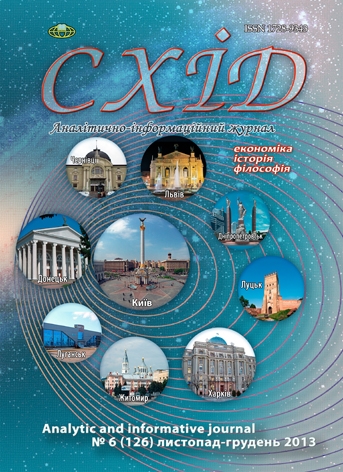Model of process of organization of effective agricultural land-tenure
DOI:
https://doi.org/10.21847/1728-9343.2013.6(126).20508Keywords:
land, land plots, land use administration, efficiency of agricultural land use, criteria for estimation of efficient land useAbstract
There has been disclosed the essence of the concept of organization of efficient agricultural land use as the process of creation of the needed organizational and territorial, legal, economic and social conditions for total engagement into production and output increase of each hectare of land while conserving and restoring soil fertility.
It has been verified that it is necessary to study the efficient agricultural land use systematically as land policy is closely related with economic and environmental policy, taxation and local development issues, as well as many other spheres of public relations. In doing so it is advisable to view efficiency of land use in three-dimensional system: economic system (economic needs of land resources and soils usage, the nature of land use, goods market, production placement, stimulation level, infrastructure development, etc.); social system (social institutions land use and land ownership, particularly, economic structure, the set of regulations and duties of a person towards land, land organization, land proprietary right, servitude, social infrastructure); environmental system (natural resources potential, agroecological features of soils use, product quality, environmental state of soils, environmental restrictions).
It has been corroborated that while forming efficient and permanent land uses it is necessary to utilize modeling methods of efficient land use with consideration of interrelations and interdependence of natural properties of lands, social, economic and environmental factors.
It has been proved that efficient agricultural land use has to include the set of measures aimed at meeting public needs through accounting and comprehensive estimation of productive capacity of land for its better use taking into account natural, social, economic and environmental conditions and end use.
There has been proposed management decision-making algorithm for efficient land use organization. The sequence of formation of criteria for economic and environmental estimation of efficient land use has been set.
Downloads
References
Барвінський А. В. Проблеми ефективного використання земельних угідь в агроландшафтах Полісся / А. В. Барвінський // Інноваційна економіка. - 2013. - № 2. - С. 146-152.
Боклаг В. А. Зарубіжний досвід у сфері державного управління земельними ресурсами / В. А. Боклаг // Актуальні проблеми державного управління. - 2011. - № 2 (40). - С. 1-7.
Веклич О. О. Економічний механізм екологічного регулювання в Україні / О. О. Веклич. - К. : Український інститут досліджень навколишнього середовища і ресурсів, 2003. - 88 с.
Вінська О. Й. Особливості сучасного стану реалізації Спільної Аграрної Політики Європейського Союзу / О. Й. Вінська // Економічний простір. - 2010. - № 40. - С. 5-19.
Екосередовище і сучасність. - Т. 1. Природне середовище у сучасному вимірі : [монографія] / [Дорогунцов С. І., Хвесик М. А., Горбач Л. М., Пастушенко П. П.]. - К. : Кондор, 2006. - 424 с.
Мартин А. Як регулюються ринкові земельні відносини в Польщі / А. Мартин, О. Коник // Землевпорядний вісник. - 2013. - № 3. - С. 26-29.
Пашков І. А. Системні основи сталого землекористування в Україні / І. А. Пашков // Вісник Запорізького національного університету. - 2009. - № 1(4). - С. 149-155.
Ступень М. Г. Екологізаційні механізми підвищення конкурентоспроможності суб'єктів аграрної сфери / М. Г. Ступень // Сталий розвиток економіки. - 2012. - № 7. - С. 179-183.
European Commission (2004): The Common Agricultural Policy Explained. - Directorate General for Agriculture, Brussels.
REFERENCES
Barvinskyi A. V. (2013), “Problems of efficient land use in agricultural landscapes of Polesia”, Innovative Economy, vol. 2. pp. 146-152 (ukr).
Boklah V. A. (2011), “Foreign experience in public land management”, Actual problems of public administration, vol. 2 (40), pp. 1-7 (ukr).
Veklych O. O. (2003), Economic mechanism of environmental regulations in Ukraine, Ukrainian Research Institute of Environment and Resources, Kyiv, p. 88 (ukr).
Vinska O. Y. (2010), “Features of the current state of implementation of the Common Agricultural Policy of the European Union”, Ekonomichnyi prostir [Economic space], vol. 40. pp. 5-19 (ukr).
Dorohuntsov S. I., Khvesyk M. A., Horbach L. M. and Pastushenko P. P. (2006), Environment And Modern Times. Vol. 1. Environment In Modern Terms, monograph, Kondor, Kyiv, 424 p. (ukr).
Martyn A. (2013), “As a regulated market land relations in Poland”, Zemlevporiadnyi visnyk [Land management Gazette], vol. 3. pp. 26-29 (ukr).
Pashkov I. A. (2009), System Basis For Sustainable Land Use In Ukraine, Visnyk Zaporizkoho natsionalnoho universytetu [Journal of Zaporizhzhya National University], vol. 1(4), pp. 149-155 (ukr).
Stupen M. H. (2012), “Ecological Mechanisms of Increase of Competitiveness of Agricultural Entities”, Stalyi rozvytok ekonomiky [Sustainability of Economy], vol. 7, pp. 179-183 (ukr).
European Commission (2004), The Common Agricultural Policy Explained. Directorate General for Agriculture, Brussels (engl).
Downloads
Published
How to Cite
Issue
Section
License
Copyright (c) 2014 Оlexandra Hulko

This work is licensed under a Creative Commons Attribution-NonCommercial-NoDerivatives 4.0 International License.
1. Authors bear responsibility for the accuracy of facts, quotations, numbers and names used.
2. Manuscripts are not sent back.
3. The publisher does not always agree with the authors' opinion.
4. The authors reserve the right to authorship of the work and pass the first publication right of this work to the journal under the terms of a Creative Commons Attribution-NonCommercial-NoDerivatives 4.0 International License. This license allows others to distribute (copy) the published work for non-commercial purposes, provided there is mandatory attribution to its authors and a link to the first publication in our journal.
5. The authors have the right to conclude separate supplement agreements that relate to non-exclusive work distribution in the form in which it has been published by the journal (for example, to upload the work to the online storage of the journal or publish it as part of a monograph), provided that the reference to the first publication of the work in this journal is included.

